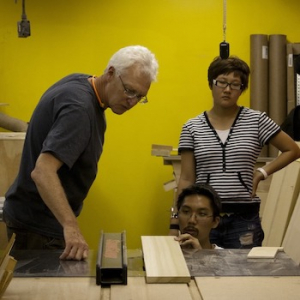
A simple dinner disrupted by flowers sparked an innovative design—a dining table that adapts to its surroundings. This idea led Steven Hill, 3D Lab director at the University of Hawaiʻi at Mānoa’s School of Architecture, to win the 2024 Lāʻau Pono Award at Hawaiʻi’s Woodshow. Sponsored by the Hawaiʻi Forest Industry Association, the award honors artists who creatively and responsibly use Hawaiʻi-grown woods, blending sustainability with design and craftsmanship.
It is always a great opportunity for the students to get creative while they are also learning about the rich materials that Hawaiʻi’s forests provide.
—Steven Hill
“The idea came from a simple dinner with my wife, where I realized that the flowers on the table were coming between us,” Hill said. “That moment sparked the question—what if a table could adapt to its surroundings rather than just be a static piece of furniture?”
Hill named his design “Baby, You’re My Centerpiece,” resulting in a beautifully crafted red eucalyptus table with a recessed, hand-blown glass vase set in a wave-textured medallion carved with a computer controlled router.
“The table is designed to be part of the meal,” Hill explained. “I wanted to create something that was not only beautiful but also functional and interactive. This table invites people to engage with it, whether by switching out the vase, using the koa cover, or adding a wine carafe.”
The red eucalyptus (Eucalyptus camaldulensis) originates from Tantalus, and was planted in the 19th century as part of a reforestation effort by King David Kalākaua. The table’s koa elements, sourced from a fallen tree in South Kona, add further layers of history and craftsmanship.

Mentoring future designers
At the 3D Lab, Hill guides students in digital fabrication and hands-on building, promoting sustainability in the real-world design. He supports the Innovation+Imagination Student Challenge, encouraging students to explore locally sourced wood for creative projects. Hill sees furniture design as an important exercise in architectural thinking, urging students to consider form, function and sustainability.
“It is always a great opportunity for the students to get creative while they are also learning about the rich materials that Hawaiʻi’s forests provide,” said Hill.

